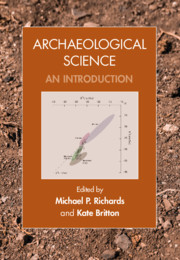Book contents
- Archaeological Science
- Archaeological Science
- Copyright page
- Contents
- Figures
- Tables
- Contributors
- Acknowledgements
- Part I Introduction
- Part II Biomolecular Archaeology
- 2 Ancient DNA
- 3 Proteomics
- 4 Residue Analysis
- 5 Isotope Analysis for Mobility and Climate Studies
- 6 Isotope Analysis for Diet Studies
- Part III Bioarchaeology
- Part IV Environmental Archaeology
- Part V Materials Analysis
- Part VI Absolute Dating Methods
- Index
- References
3 - Proteomics
from Part II - Biomolecular Archaeology
Published online by Cambridge University Press: 19 December 2019
- Archaeological Science
- Archaeological Science
- Copyright page
- Contents
- Figures
- Tables
- Contributors
- Acknowledgements
- Part I Introduction
- Part II Biomolecular Archaeology
- 2 Ancient DNA
- 3 Proteomics
- 4 Residue Analysis
- 5 Isotope Analysis for Mobility and Climate Studies
- 6 Isotope Analysis for Diet Studies
- Part III Bioarchaeology
- Part IV Environmental Archaeology
- Part V Materials Analysis
- Part VI Absolute Dating Methods
- Index
- References
Summary
All the inheritable material possessed by an organism, the genome, is stored as DNA, the study of which has made an enormous impact upon archaeological science. The proteome is the suite of proteins produced by the genome at any one time. The field of proteomics is the study of this proteome, and uses mass spectrometry to identify proteins by their amino acid sequence.
- Type
- Chapter
- Information
- Archaeological ScienceAn Introduction, pp. 35 - 69Publisher: Cambridge University PressPrint publication year: 2020



